For the better part of the past two decades, Colleen Plumb has examined the complex relationship we hold with animals from various points of view. In 2011, Plumb published Animals are Outside Today, and is currently working upon a series of works, Thirty Times a Minute, that looks at elephant behavior while held in captivity by way of video taping the subjects then projecting this material in public places at night. This week The COMP Magazine caught up with Plumb at her north side studio to discuss the noted book, her current body of work, what she values most in her artistic practice, and how she shares all of this with her students.
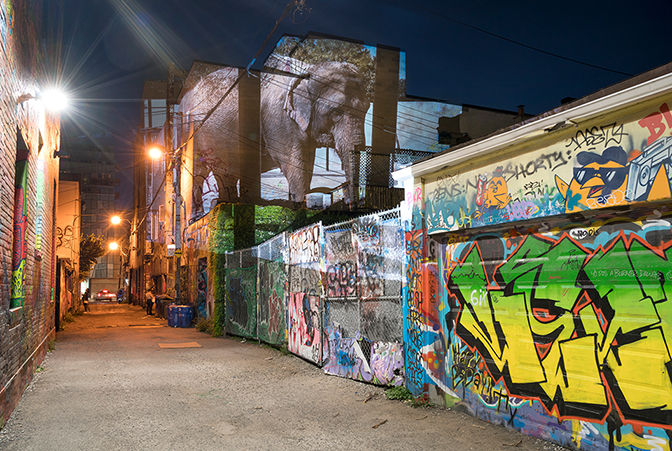
Colleen Plumb, Babe (Coal Valley, IL) at Rush Lane, Toronto, Ontario, 2017
I’m wondering if we can start with a little background? You grew up in Chicago. Are there any early experiences that you see that connect to your current aesthetic investigations?
I grew up in Rogers Park in the 70s and 80s, and was outside all the time in someone’s backyard or in the alleys and gangways. I remember a lot of time was spent in the tree in our yard. My dad was very into camping and canoeing and he shared his appreciation of the natural landscape with my siblings and me. It is probably where he sou¬ght refuge from his job as a homicide detective in Chicago. There was a reverence for nature instilled in us by him – at the top of every ski hill we said a prayer of gratitude. I am sure all of that influences me today—seeking a connection to, noticing or observing the wild in urban settings.
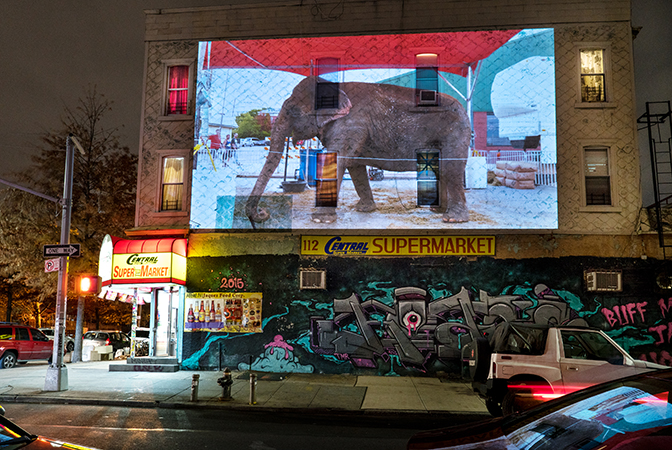
Colleen Plumb, Cindy (Peru, Indiana) at Central Supermarket, Bushwick, Brooklyn, New York City, 2016
In 2011 you published Animals Are Outside Today with Radius Books in Santa Fe, N.M. In this photobook, you examine the relationship between humans and animals, in part, that grey area full of contradictions. Can you share with us what prompted this body of work?
During my first review in graduate school, I presented a selection of black and white pictures, my attempts at investigating the strange and eerie. I was researching Meatyard at the time. I was not at all clear about a thesis. Many of the pictures contained plants and animals, something that was unintentional, but was obvious during the review. So, all at once my pictures became a guide, and I began exploring the role of artifice in urban environments and the ways animals are woven into contemporary society. I remember it was a very exciting time because suddenly I saw animals (or representations of animals) everywhere; I had a new framework to look at the world filled with absurdity and grace.
From a very early point I thought of the series in terms of sequence. I would cut apart my contact sheets and keep them in sketchbooks, always rearranging their order. I’d integrate the new pictures into the series puzzling how they impacted the others. The book grew over 12 years of this process; I made dummy books, and began to think more seriously about it as a published work. During the last several years making the series, I went to fur shops, meat packers, the circus, a tannery (places I had to gain specific access). That was the time I began to face the more disturbing realities about how animals infuse our lives, which led me to my current work.
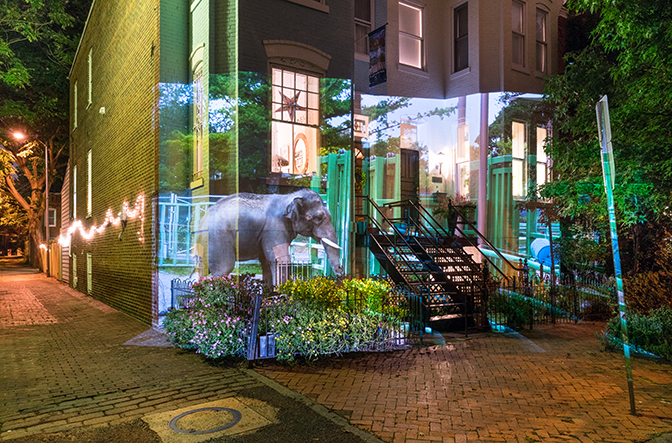
Colleen Plumb, Doc (Syracuse, NY) at 10th and Constitution, Washington, D.C., 2017
In the past couple years you have been projecting video of elephants in captivity on various types of architecture, and photographing the environment in which the projections are cast. What is your intent in these video installations entitled Thirty Times a Minute?
The intent is to interrupt public space and see what happens, who notices and how that can generate conversation. During projections I can share about the project and also have the chance to witness strangers interacting with one another or just pausing in their day to watch the video. I’m interested in the identification people have with the stress they are bearing witness to. The elephants rock incessantly in all of the zoos I have been to around the world. Regardless of the size of enclosure or amount of money spent on its renovation, at least one or two (or more) of the elephants will still incessantly rock back and forth, and it destroys their joints and reveals their stress. The act is called “stereotypic behavior” by biologists and it is never exhibited in the wild. At the zoo, people usually do not stand and watch long enough to fully absorb the neurotic behavior before their eyes. If they do notice it they make jokes or move on. Usually children are the ones who point out the behavior and will ask why is the elephant doing that? Countless times I have heard adults tell them it’s dancing. No one wants to mention the obvious insanity they are witnessing. But when I inject the video into the public sphere, people do see what is happening—they see what spectators at the zoo won’t allow themselves to comprehend. I am interested in that tension between the original layer of experience paired with a replaying of it in a different context.
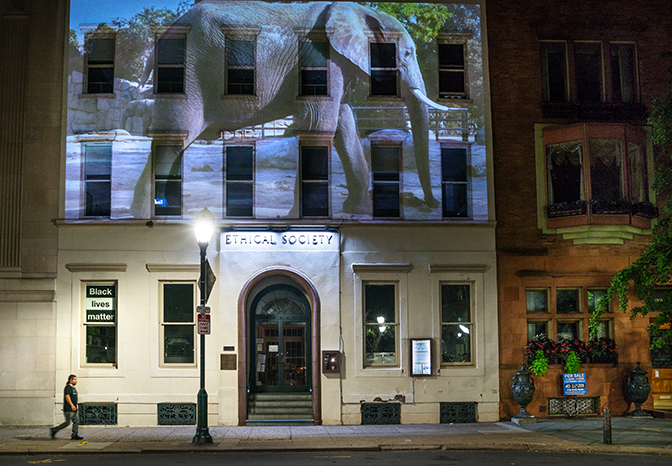
Colleen Plumb, Tembo (Berlin, Germany) at Ethical Society, Philadelphia, PA, 2017
How do you select the locations?
At first, I looked simply for high-traffic, low-ambient-light areas, with a flat wall having a conducive surface to project the video. After several locations like that, I began thinking about surface and how the image worked layered with the architecture. Next, I considered how the projection surface could break apart the video in interesting ways (different depths, etc.) Each projection presented a new challenge and gave me new ideas- I became more specific in thinking about how the image/scene interacted with the projection surface. When I was in Portland, I had an idea to project the video on a waterfall and after that I started projecting the video in natural landscapes as a counterpoint to the urban projections. The elephant started to look like it was alive on the land, which next led to integrating the elephant on surfaces in similar ways on the buildings. Working with the projected image has been an evolution. Playing with scale, choosing which elephant to project in which city is also part of the process.
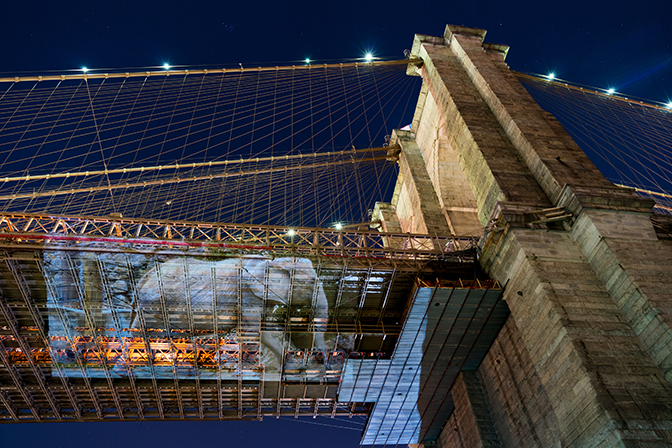
Colleen Plumb, Drumbo (Vienna, Austria) at Brooklyn Bridge, New York City, 2016
What do you value most in your art practice?
To have an art practice at all is pretty special- I get to make pictures and video about what I am interested in. I feel fortunate to have the chance to try, over and over, inching closer to an idea and experimenting with how to convey it. I especially value being in community with other artists who are also figuring out their ideas through their work. We are all tackling something or struggling and working through ideas in one way or another and it’s fantastic and inspiring to witness their development because I am nourished and want to try harder to grow and make meaningful work.
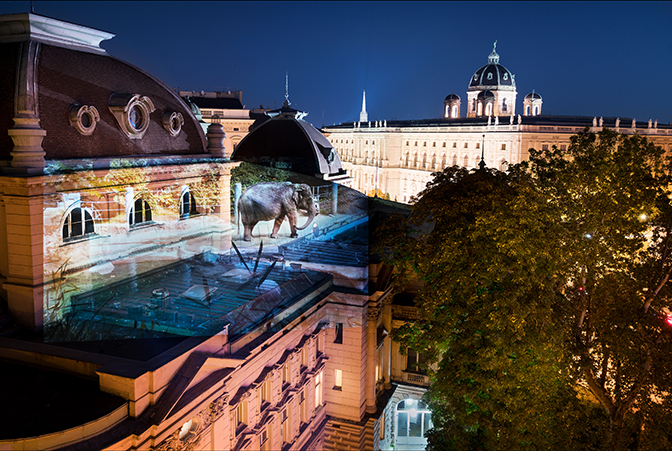
Colleen Plumb, Guida (Seattle, Washington) at Volkstheater, Vienna, Austria, 2016
You’ve taught in the Department of Photography at Columbia College since 1999. Do you see any overlap between your art practice and teaching? Are there any recurring items that you share with your students to assist them in assembling a foundation in their art practice?
I bring my work into my teaching regularly. I think it is important to share my experience with my students, to encourage the idea that developing a project can take a long time and they may often encounter rejection or disappointment to find any degree of success. And to question what is success anyway. Everyone measures success differently. I share what I am currently working on, as it inevitably relates in some way to what I am teaching – I share my trials and mistakes and certain practical things. One recurring thing I try to reinforce is to keep going even through doubt.
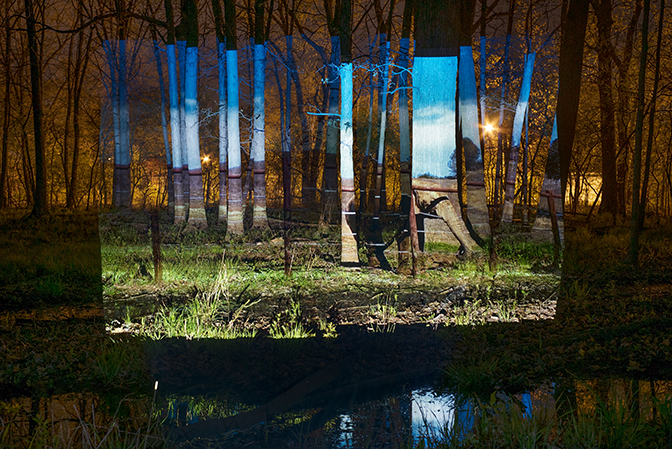
Colleen Plumb, (PAWS Sanctuary, San Andreas, California) and LaBagh Woods, Chicago, Illinois, 2016
You recently had work at the Catherine Edelman Gallery in River North. What’s the plan for the
remainder of 2017?
I had three transparency photographs in light boxes and a 2-channel video included in the Targeted exhibition at Catherine Edelman Gallery. The video, Path Infinitum, was projected on the front gallery windows each night until 1 a.m. throughout the summer. In that location the video was inserted into public space in a unique way, on the glass at street level, where many people walk by toward the train or through the neighborhood, while all the time the animals in the video were circling or pacing incessantly out front, out of context, acting as messengers, I hope, to soften, surprise, and inform people about the plight of captive animals.
I am working on editing for an upcoming book of photographs I have made during my projections in cities around the world. Not only do I project the video as a public happening, I also separately make photographs of the projected elephants. The photographs are from Chicago, Portland, Detroit, New Mexico, Wyoming, Idaho, New York, Toronto, Rochester, Philadelphia, Cleveland, Washington D.C., Vienna, Paris, Berlin, and Prague. I am planning a couple more locations this coming year to finalize the series. The book will be published by Radius books in 2018 (title TBA). I also am working continuously on a few other projects simultaneously: ongoing pictures of my family about the joy and tyranny of growing up/motherhood and a video interview project with Activist for Humanity, Roosevelt Burrell.
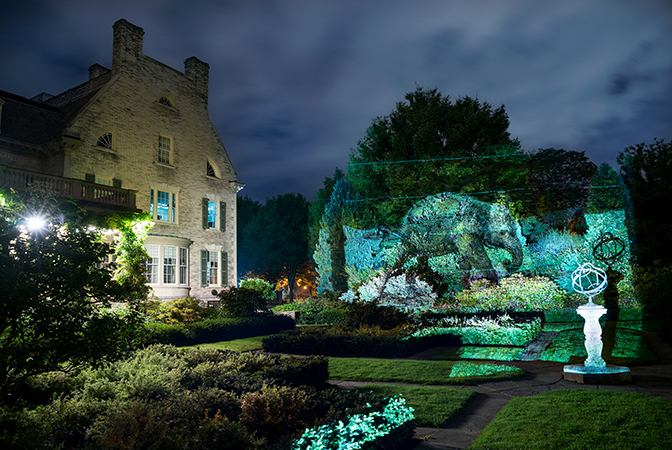
Colleen Plumb, Malee (Oklahoma City, OK) at George Eastman Museum, Syracuse, NY, 2017
For additional information on the work of Colleen Plumb, please visit:
Colleen Plumb – http://www.colleenplumb.com/
Museum of Contemporary Photography Chicago – http://www.mocp.org/collection/mpp/plumb_colleen.php
Catherine Edelman Gallery – http://www.edelmangallery.com/artists/artists/o-z/colleen-plumb.html
New York Times – https://lens.blogs.nytimes.com/2011/10/03/love-and-loss-and-the-animal-kingdom/
Radius Books – http://radiusbooks.org/books/colleen-plumb-animals-are-outside-today/
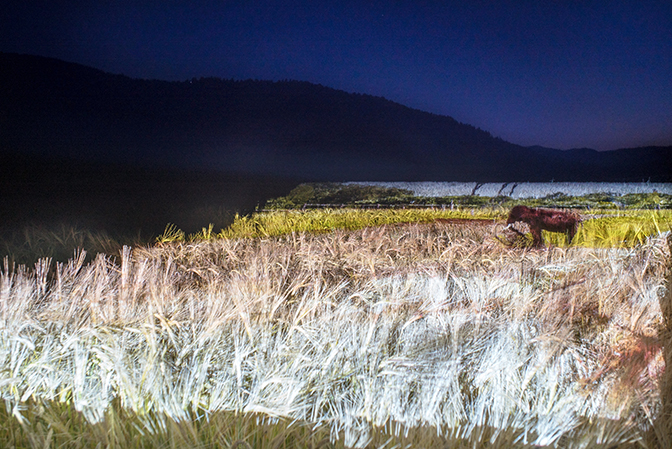
Colleen Plumb, Tombi (Indianapolis, Indiana) at Driggs, Idaho, 2015
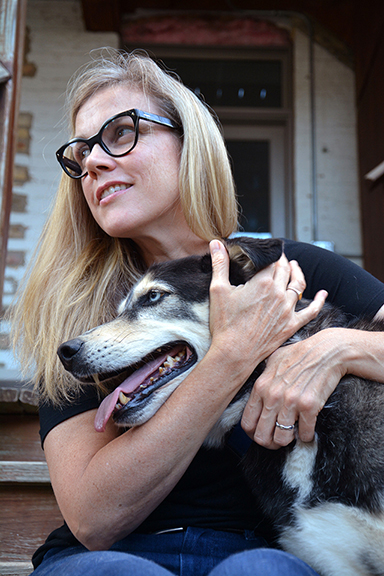
Colleen Plumb, photographer, with Edmund, Chicago, IL, 2017
Artist interview and portrait by Chester Alamo-Costello


